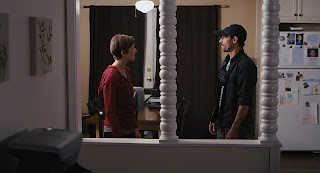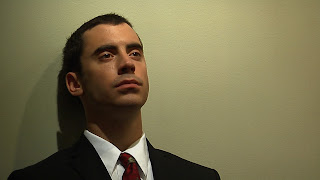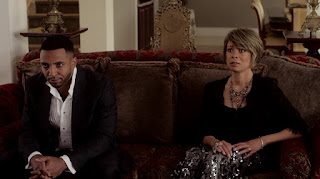VOD Review - We Are Three
Yes, there have been an overabundance of love triangles, but that's not exactly what Stamm is establishing here. A love triangle is three people vying for a coupling or a match-up but one or two people being indecisive about what the match-up or pair should be. Usually, it involves one person having to choose between two individuals who don't know or want nothing to do with each other. Sometimes, the love triangle involves one person having a secret affair, but normally it's just one person dating multiple people. The goal is typically that the pair gets married, a tradition that only involves two people.
An early but modern example, which bucked the trend, was Spike Lee's She's Gotta Have It (1986). Lee's film was about one person, a queer black woman, being involved with multiple people but still it was about that one person engaging with those multiple people, one at a time. In Lee's film, however, she wasn't just dating two people. She was dating three, so it's not quite a similar comparison. If ménage-a-trois is a rare depiction, then poly-amorous relationships beyond three people is even more rare. One exception was The King and I (1956), which was about the Siamese monarch and his many wives, dozens in fact. The biggest example on TV was HBO's Big Love, which was about a Mormon man having three wives. It's also probably the best depiction of polyamory that I've seen.
What Stamm is specifically trying to do here has been attempted in film before. The first in my memory was Andrew Fleming's Threesome (1994). Next was John McNaughton's Wild Things (1998). Next was Rob Hardy's Trois (2000). Then, there was Y Tu Mamá También (2001). Then, there was A Home at the End of the World (2004). Recently, there was Professor Marston and the Wonder Women (2017). Each film really illustrates how these kind of three-way relationships can either succeed or fail. Stamm's film sidesteps a lot of the natural conflict that would arise and presents a quasi-utopian scenario here.
Carlos Etchevers stars as Juan Ignacio aka "Nacho," an accountant who works at a bank in Buenos Aires. One night, he goes to the birthday party of his ex-girlfriend with whom he broke up three months ago. There, he meets a friend of the birthday girl's co-workers named Ana, played by Flor Dragonetti. Ana is a web designer who runs her own business. She's been divorced for two years after cheating on her husband. Both of them together meet Sebastián, played by Juan Manuel Martino. Sebastián is the bartender for the party. He bounces around from place to place. He's a free-spirit type. He's bisexual and takes an interest in both Nacho and Ana at the same time. He flirts with and propositions them both at the same time.
It doesn't take long and he's very open and direct about the fact that he wants to be in a committed relationship with both of them at the same time. Both of them are open to having a sexual relationship, which is mostly what a ménage-à-trois is, but, both of them are skeptical about being in a committed relationship between all three. They do have the three-way sex, but the rest of the film is more or less a negotiation about how they navigate a poly-amorous relationship between the three where they live together and do everything together. They have a trial period where Sebastián is sure about what he wants, but it's a matter of if Nacho and Ana will choose to go along with this arrangement forever.
Stamm gets points for putting bisexual representation at the forefront of his film. There are a lot of LGBT films that deal with bisexuality as a matter of technicality, but it's rare that we have such a strong and proud bisexual identify as such without any confusions or complications. According to recent studies, bisexual people are the largest group within the LGBT community, but you'd never know that through even mainstream media or even a lot of queer media. Women are also more likely to identify as bisexual.
This means that when Sebastián approached Nacho and Ana, the likelihood that they would be bisexual too were somewhat good. Argentina like a large chuck of South America is a gay-friendly and progressive place. Arguably, in order for the threesome to truly work, two of the three would have to be bisexual. In films like Threesome or A Home at the End of the World, the reason the threesomes didn't work is because there was no bisexual or only one. In Professer Marston and the Wonder Women, that relationship did work because there were two bisexuals. The threesome consisted of one man and two women. The two women were bisexual.
If the trio consists of two people of one gender and the third of a different gender, having the two people of the same gender be bisexual seems like the best bet. Nacho and Sebastián are both the same gender and both are bisexual, so it works. It didn't seem at first as if Nacho were bisexual. This might be his first same-sex encounter, but his ease with it suggests that he's perhaps had sex with men before. Essentially though, Sebastián got lucky that Nacho ended up being bisexual.
In reality, there's probably a website or a social media app that allows people wanting threesomes to find each other more easily. The casual way in which it happens here is plausible but unlikely. The probability that you'd get a threesome where all three are the same gender is likely higher. In HBO's Big Love, the configuration works because the wives don't have sex with each other. That creates problems that aren't present between Nacho, Ana and Sebastián, but I don't know if it's worse. It's just different.
In terms of this film though, because there's no real conflict or drama. It makes the narrative somewhat boring. Unlike Big Love, these three aren't trying to get married or assert any kind of legal rights, which might cross polygamy laws, so there's no external strikes coming at them. Stamm doesn't show the scenes of the three of them telling their families about their poly-amorous relationship. Even friends of Nacho who question him about it don't generate anything more than simply nonplussed reactions.
Those external strikes are almost unnecessary as Stemm's conversations among the three do address a lot of questions and issues that the average person would have about this arrangement. The one question that didn't get addressed though was why. Why three? The presumption here is that a person is capable of loving more than one person at a time. Here, we see three people loving two people at the same time. If that's true, then this movie supposes that a person does so without judgment. In She's Gotta Have It, the supposition is that a person can love more than two at the same time and she does so without judgment.
Sebastián decisively says that he wants to love two people at once, a guy and a girl. My question is why stop there. Why not love three people at once or four people at once or five? Why is his limit only two? If you believe people who study gender-queer identities, then you know there are more than two genders, more than two sexes. There's a spectrum. If he's going there, why limit to just two? The Netflix series Sense8 went to that question. This one doesn't.
We Are Thr3e.
Not Rated but contains full-frontal male nudity and graphic sexuality.
Running Time: 1 hr. and 28 mins.
Available on VOD like iTunes.

















Comments
Post a Comment